
Tiger beetles are a family of beetles, Cicindelidae, known for their aggressive predatory habits and running speed. The fastest known species of tiger beetle, Rivacindela hudsoni, can run at a speed of 9 km/h, or about 125 body lengths per second. As of 2005, about 2,600 species and subspecies were known, with the richest diversity in the Oriental (Indo-Malayan) region, followed by the Neotropics. While historically treated as a subfamily of ground beetles (Carabidae) under the name Cicindelinae, several studies since 2020 indicated that they should be treated as a family, the Cicindelidae, which are a sister group to Carabidae within the Adephaga.

The longhorn beetles (Cerambycidae), also known as long-horned or longicorns, are a large family of beetles, with over 35,000 species described.
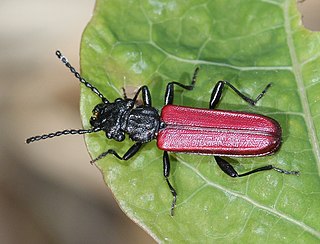
The Cucujidae, or flat bark beetles, are a family of distinctively flat beetles found worldwide under the bark of dead trees. The family has received considerable taxonomic attention in recent years and now consists of 70 species distributed in five genera. It was indicated Cucujus species are scavengers, only feeding on pupae and larvae of other insects and on other subcortical beetles such as their own. Since the Cucujidae prey on larvae of potentially tree damaging beetles that spread fungal diseases, they are considered to be beneficial to the health of living trees.
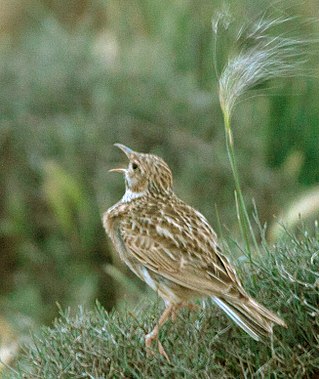
Dupont's lark is a species of lark in the family Alaudidae of the monotypic genus Chersophilus. It is found in northern Africa and Spain.

Ochodaeidae, also known as the sand-loving scarab beetles, is a small family of scarabaeiform beetles occurring in many parts of the world.

Cicindela, commonly known as common tiger beetles, are generally brightly colored and metallic beetles, often with some sort of patterning of ivory or cream-colored markings. They are most abundant and diverse in habitats very often near bodies of water with sandy or occasionally clay soils; they can be found along rivers, sea and lake shores, sand dunes, around dry lakebeds, on clay banks, or woodland paths.
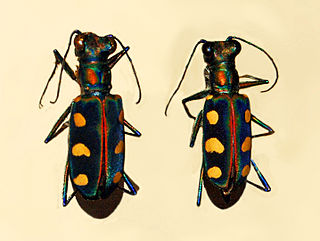
Cicindela aurulenta, common name blue-spotted or golden-spotted tiger beetle, is a beetle of the family Cicindelidae.
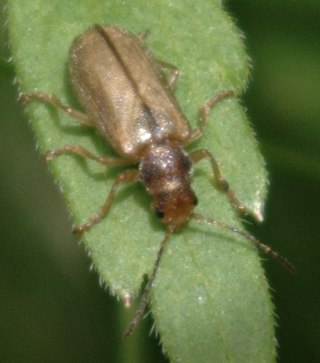
Syneta is a genus of leaf beetles in the subfamily Synetinae. There are about 11 described species in Syneta. The genus is entirely holarctic in distribution, with species appearing in North America, Siberia, East Asia and Northern Europe.

Bromius obscurus, the western grape rootworm, is a species of beetle in the leaf beetle family. It is the only member of the genus Bromius. The distribution of the species is holarctic; it can be found in North America, wide parts of Europe, and Asia. The species is a known pest of grape vines in Europe and western North America.

Laemophloeus is a genus of beetles; it is the type genus of the family Laemophloeidae. The genus has been almost completely reviewed in modern times.

Chelonariidae or turtle beetles is a family of beetles in the superfamily Byrrhoidea. It was described by Blanchard in 1845. There are 3 genera with around 300 described species. Little is known of their ecology, though it seems they are associated with the roots of orchids and the nests of ants and termites. Their exoskeletons are heavily sclerotised and their limbs can be effectively retracted into their bodies due to the presence of socket-like cavities. Adult specimens have seed-shaped bodies that are typically colored brown or black with lighter patches.

Richard Henry Puech Dupont or Henry Dupont was a French naturalist and a collector and trader in specimens of beetles and birds. He was the younger brother of the naturalist Leonard Dupont and many references in old French works merely mention Monsieur Dupont which has led to confusion between the two although in some works Leonard is referred to as the senior Dupont senior (aîné) and Henry as the younger (jeune). For the larger part Henry was into beetles and entomology while Leonard was more associated with birds. Many species of beetle were named by Henry Dupont and some are named after him by others.
Cicindela aulica is a species in the tiger beetle family Cicindelidae. It is found in Africa, southern Europe, and southwest Asia.

Euwallacea fornicatus is a species complex consisting of multiple cryptic species of ambrosia beetles, known as an invasive species in California, Israel and South Africa. The species has also been unintentionally introduced into exotic greenhouses in several European countries. As the rest of the ambrosia beetles, E. fornicatus larvae and adults feed on a symbiotic fungus carried in a specific structure called mycangium. In E. fornicatus, the mycangium is located in the mandible. The combination of massive numbers of beetles with the symbiotic fungus kills trees, even though the fungus alone is a weak pathogen.
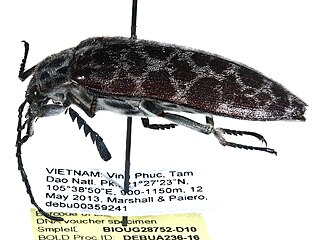
Eulichadidae is a family of beetles belonging to Elateriformia. There are two extant genera, Eulichas with several dozen species native to the Indomalayan realm of Asia, and Stenocolus, with a single species native to Western North America. The larvae are aquatic, with the larvae of Eulichas being found in sandy sediments of clean forest streams, while the larvae of Stenocolus are found under rocks and in leaf packs in low elevation streams and rivers. They are herbivious/saprophagous with larval specimens of Eulichas having been found with wood particles in their stomachs, while the larvae of Stenocolus are known to feed on decaying roots and detritus. The adults are terrestrial, with specimens of Eulichas typically found using light, while specimens of Stenocolus are typically found in riparian vegetation, and are not attracted to light. Potential extinct genera have been described from Mesozoic rocks, but the placement of several of these taxa in the family is disputed.

Eumolpini is a tribe of leaf beetles in the subfamily Eumolpinae. It is the largest tribe in the subfamily, with approximately 170 genera found worldwide. Members of the tribe almost always have a longitudinal median groove on the pygidium, which possibly helps to keep the elytra locked at rest. They also generally have a subglabrous body, as well as appendiculate pretarsal claws.

Cicindela scutellaris, the festive tiger beetle, is a species of flashy tiger beetle in the family Cicindelidae. It is found in North America.

Chrysochus is a genus of leaf beetles in the subfamily Eumolpinae. It is known from North America, Europe and Asia.
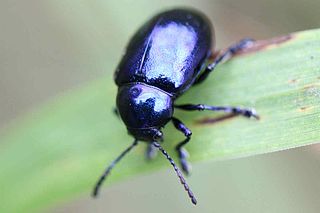
Chrysochus asclepiadeus is a member of the leaf beetle subfamily Eumolpinae. It is considered the type species of the genus Chrysochus, though it has sometimes been placed within the genus Eumolpus. It is the only species of Chrysochus distributed in the western Palaearctic. It is mainly found in Europe, though it is also known from Kazakhstan and Turkey in Asia.

Ampedus is a genus of click beetles in the family Elateridae. There are currently 461 recognized species of Ampedus beetles. It has a cosmopolitan distribution, but is found mostly in the Holarctic region, primarily in North America, Europe, and Asia. The oldest known fossil from this genus was found in Eocene Baltic amber, estimated to be from 38.0 to 33.9 million years ago.



















